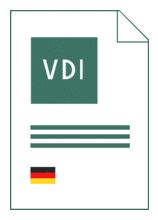Standards Worldwide
Standards Worldwide
Phone +49 30 58885700-07

Technical rule [CURRENT]
VDI 2062 Blatt 2:2007-11
Vibration insulation - Insulation elements
- German title
- Schwingungsisolierung - Schwingungsisolierelemente
- Publication date
- 2007-11
- Original language
- German, English
- Pages
- 52
- Publication date
- 2007-11
- Original language
- German, English
- Pages
- 52
Product information on this site:
Quick delivery via download or delivery service
Buy securely with a credit card or pay upon receipt of invoice
All transactions are encrypted
Short description
In vibration isolation, vibration isolation elements are used for reducing transmitted mechanical vibrations. Vibration isolation is subdivided into: Source isolation (emissions protection): Forces originating in a machine or system are transmitted to the environment in reduced form; Receiver isolation (immissions protection): Vibrations present at the place of installation, specified as vibration displacements, vibration velocities or accelerations, are transmitted in reduced form to the machine or system. The vibration isolation elements required for vibration isolation have resilient and damping properties. Even in the case of structure-borne sound insulation, transmitted vibrations should be reduced but with the real aim of reducing the secondary air-borne sound arising due to structure-borne sound. Basically there is no difference between vibration isolation and structure-borne sound insulation although tuning frequencies ≤25 Hz are generally aimed at for vibration isolation. In the case of structure-borne sound insulation the tuning frequencies are often higher. The structure-borne sound insulation elements required for structure-borne sound insulation have resilient and damping properties. If the ratio between tuning frequency and the disturbing exciter frequencies is taken into consideration and also the natural frequencies of the isolating elements themselves (see Section 3.1), vibration isolation elements can also be used for structure-borne sound insulation and vice versa. The terms insulation instead of vibration or structure-borne sound insulation and insulating elements instead of vibration or structureborne sound insulation elements should be avoided.
Content
ICS
17.160
Replacement amendments
This document replaces VDI 2062 Blatt 2:1976-01 .
Also available in
Loading recommended items...
Loading recommended items...
Loading recommended items...
Loading recommended items...
